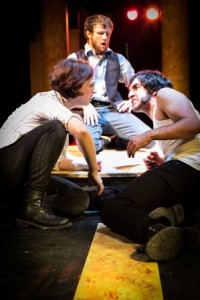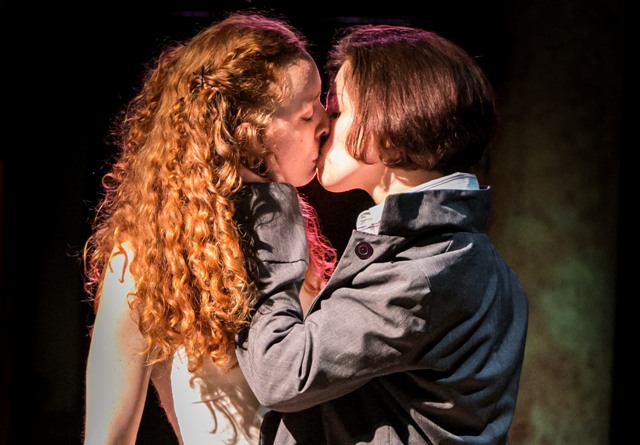Two households, both alike in dignity, In fair Verona, where we lay our scene,
From ancient grudge break to new mutiny, Where civil blood makes civil hands unclean…
West Philly’s Curio Theatre Company created a lot of buzz over the summer when they announced they would be mounting a female version of Shakespeare’s love story ROMEO & JULIET. A piece was posted to the Drudge Report about director Krista Apple-Hodge’s concept of casting two actresses in the lead roles, and the hatin’ began. I read several of the comments posted by people from around the country who don’t even know Curio and its ensemble of artists—and it was scary people. So, needless to say, I was excited to see the production and judge it on its own merits.
Shakespeare penned ROMEO & JULIET early in his career (scholars date it somewhere between 1591 and 1595)—and had an instant hit on his hands. To this day, it is probably one of his most produced works. (There is currently an interracial version on Broadway that hasn’t seemed to have brought out the crazies…) Most everyone should be familiar with the plot by now: the teenaged son and daughter of two feuding families fall madly in love, but wind up committing suicide when they can’t be together. The play is required reading in many schools—and there have been several film versions of the Bard’s original text and others adaptations of it. I have to confess it was my crush on Leonard Whiting in Zefferilli’s 1968 version that started my love of Shakespeare.

Rachel Gluck as Romeo, Steve Carpenter as Benvolio and Eric Scotolati as Mercutio in Curio Theatre Company’s ROMEO AND JULIET. (Photo credit: Rebecca Miglionico)
As with most of his works, Shakespeare borrowed his story from other sources. In this case it was an Italian tale, translated into verse as The Tragical History of Romeus and Juliet by Arthur Brooke in 1562 and retold in prose in Palace of Pleasure by William Painter in 1567. To flesh out the story—and add more excitement, I’m sure—Shakespeare invented the characters of Mercutio (Romeo’s cousin) and Paris (nephew to the Prince who is vying for Juliet’s hand in marriage). The family names of Capulet and Montague may have come from Dante’s Divine Comedy—which mentions the houses of Montecchi and Cappelletti in Canto 6 of Purgatorio.
As always, Curio has created an entire environment in the Calvary Center’s former sanctuary that serves as their playing space. Audiences enter through a plaster and brick arch into what appears to be a piazza with marble columns and a large planked church door. At the center of this is a circular platform raised approx. 6—8 inches off the floor. Characters appear and disappear from all around the playing space, which keeps the action flowing nicely. Seats are on 3 levels—including two “balcony” sections. The actors have several levels to perform upon as well. Juliet’s chamber is on a raised area in front of the exposed pipe organ, with a catwalk and stairs coming off of that to serve as her balcony. Once again, Paul Kuhn has proven to be one of the most creative and talented designers in town. Tim Martin’s lighting does a lovely job of creating the appropriate mood needed and Aetna Gallagher’s contemporary costuming is interesting. I did wonder at Juliet getting married in jeggings however. Patrick Lamborn has designed an interesting soundscape that is a unique blend of Renaissance and contemporary that worked well to underscore the action.
I found director Krista Apple-Hodge’s Act I to be rather frenetic; it felt a little like they were trying too hard—which is very unusual for Curio. They have a truly talented company of actors—and for the most part they performed their roles well. Rachel Gluck portrays Romeo, and does an admirable job of walking a fine line between a somewhat tomboyish young woman who is attracted to another woman and lesbian stereotypes. Isa St. Clair is Juliet—playing her as a girl who never thought the person she would love would be another female. She has some wonderful moments of expressing amazement at discovering love. Both actresses are adept performers, but at times their natural maturity was too hard to ignore—the decision was made to make Juliet almost 18 as opposed to 14 as stated in Shakespeare’s text. I’m assuming that was an effort to deal with the fact that Ms. St. Clair is a very statuesque and elegant woman. Lord and Lady Capulet have been combined into one role; as played by Aetna Gallagher, Lady C. is strong-willed and runs her household with an iron hand. Steve Carpenter moves deftly between the roles of Benvolio, Friar John and First Watchman; he handles each quite nicely. Josh Hitchens makes an excellent Friar Lawrence, and also pops up as Sampson, 1st Guard and Servant 1; the roles of Lord Montague, Peter (a Capulet servant) and the Apothecary are well executed by Ken Opdenaker. Stalwart Company member Harry Slack turns in his usual solid performance as both Count Paris and the Prince (although, I felt the “All are punished” speech at the end lacked any fire). There were some adorable touches of Paris as a shy awkward suitor that were fun to watch. New Company member Colleen Hughes takes on the roles of Tybalt, the Nurse and 2nd Watchman; I didn’t find her as adept as the others, but if she overcomes the tendency to mug, she will soon be able to hold her own amongst her fellow actors. Finally there’s Eric Scotolati as 2nd Citizen, Balthasar and Mercutio. Scotolati is an engaging and intelligent performer, so I was disappointed at the choice to play Mercutio as a crude lout humping everything in sight. The character has some of the cleverest speeches in the play, full of wit and wordplay, I felt the approach made here lost all of that and it didn’t ring true to me.
Ms. Apple-Hodge’s direction settled down nicely in the second Act and the company’s portrayal of the tragic chain of events that lead to the deaths of Romeo and Juliet played much better in my opinion. The use of candlelight and Lady Capulet’s placement of a rosary in Juliet’s presumably dead hands were quite effective.
On a whole, this is an entertaining evening of theatre, and I applaud Curio for taking a fresh look at the text. There were a few elements that didn’t quite gel for me, but that may be personal preference. Ultimately, my attention was held throughout; I recommend everyone check this production out for themselves and form their own thoughts. There is no agenda here, the Company is not promoting an alternate lifestyle, they just wanted to try something different—and there’s nothing wrong with that. Shakespeare’s stories have remained relevant for over 400 years; their universality has opened them up to all sorts of interpretations. And it is always intriguing to see what new concepts theatre companies come up with to relate the story to their audiences. It is no surprise that this, possibly the ultimate love story, has remained one of his most popular.
For never was there a story of more woe than this of Juliet and her Romeo.
ROMEO and JULIET
by William Shakespeare
Directed by Krista Apple-Hodge
October 3rd—November 2nd, 2013
Curio Theatre Company
Calvary Center for Culture & Community
4740 Baltimore Avenue
Philadelphia, PA 19143
215-525-1350
www.curiotheatre.org


